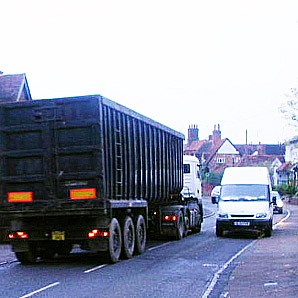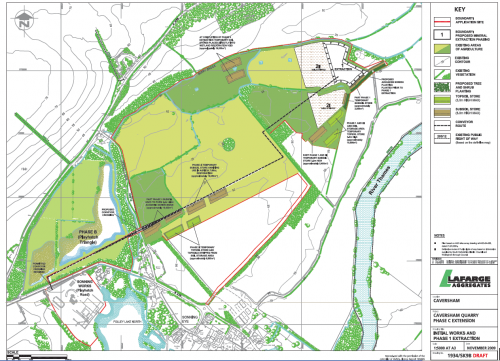July 05, 2011
Support SEAG at the book sale this Saturday!
00:07 | Permalink | Comments (0)
April 11, 2011
No news yet on Lafarge application
A planning application for 30+ years gravel extraction on land along the Thames towards Shiplake has yet to appear on the Oxfordshire County Council website.
Lafarge Aggregates have confirmed their application is imminent. Their website has details of an exhibition held last summer. SEAG will ensure the voice of local people is heard when the application (which is expected to consist of many pages) is finally received.
Confusingly, they continue to deliberately refer to 'Spring Lane, Caversham' - implying that the area is not in fact attractive Oxfordshire countryside, but a built up urban connurbation.
12:15 | Permalink | Comments (1)
Sonning volunteers continue heavy lorry blitz

The scourge of overweight lorries choking local roads is being tackled by a group of dedicated volunteers who have been out again today taking the numbers and photos of overweight lorries crossing Sonning bridge. They work with Oxfordshire Trading Standards, who disappointingly have only sent out warning letters for the last 2 years to offenders caught breaking the 7.5 tonne weight limit. Their efforts are supplemented by the data from Automatic Number Plate Recognition cameras on the bridge - which mean that in seconds police have details of every car using the crossing.
11:57 | Permalink | Comments (0)
March 21, 2011
Lafarge minerals application expected in late April or soon after
The gravel giant is shortly expected to submit a planning application to Oxfordshire for another so-called extension to the sand and gravel workings at Sonning Eye. This would take them along the river valley towards Shiplake, coming within 50m or so of the Thames Path.
SEAG will review the application carefully and will report to local people what steps it thinks are necessary. We are already concerned that any reduction in the ability of the floodplain's ability to absorb flooding (both during or after the works) could be diasterous for houses in both Sonning Eye and lower Caversham.
Predicting the future capacity of the floodplain with accuracy is notoriously difficult, and as Professor Myles Allen, of Oxford University’s Department of Physics said recently:
‘whether or not a flood occurs in any given year is still an ‘Act of God’ but, with the help of thousands of climateprediction.net volunteers, we are beginning to see how human influence on climate may be starting to load God’s dice.’
OCC Cabinet voted on 16 February was to agree the County Council's strategy approach for mineral working. This now goes out for consultation in June/July. This means concentration of working in existing areas, including at Sonning Eye. Specific sites for extraction will be selceted in a more detailed site allocation process that will follow.
The consultation results will be received before the strategy is agreed by full council for submission to the Secretary of State. Early in 2012, the strategy will be published for formal representations, which will then be considered by an inspector. HIs report is binding. The whole process will be over by the beginning of 2013.
23:56 | Permalink | Comments (0)
March 05, 2011
Gobbling up the landscape at Sonning Eye
Work is underway to extract gravel from 'the triangle' at Sonning Eye. Much of the site has been stripped of topsoil; large soil bunds store the surplus and a conveyor is in place to carry away the material. The impact on the lanscape is clearly visible from a public footpath on the hillside above.
SEAG has concerns about the possible impact of these bunds on the flow of flood water in the area. A few hours delay in the dispersal of floodwater could cause disasterous domestic flooding. Once the gravel extraction begins Lafarge have three years to complete work. Their application promises extensive restoration afterwards.
16:10 | Permalink | Comments (1)
October 20, 2010
Oxfordshire Cabinet supports continued gravel extraction at Sonning Eye
Bad news for Sonning Eye and the surrounding areas. As part of the agreement of its minerals strategy for the next ten years, the OCC Cabinet voted on 19 October to support continued minerals extraction in the so-called 'Caversham' area – which means the Sonning Eye pit.
A planning application for new digging on site continues to be expected, perhaps sometime before Christmas. SEAG is resolved to fight this.
In the strategy plans, OCC consultants will now report on the amount of gravel to be produced. This has to be agreed with the Government and then a plan prepared for its production. If the existing areas cannot supply it, then new areas will be brought in. This plan will go out to public consultation in the spring and then be considered further. It is expected that the plan will go to the Secretary of State for approval by early 2012.
A Public Enquiry may be called and a motion will be put before the full OCC Council of 74 Councillors, along with any legal challenges from excavation companies and other pressure groups.
The supporting documents are available on this site, with the relevant passages highlighted. Or follow this link to Oxfordshire's site.
The new strategy:
- wrongly states that there are no archaeologically significant sites at Caversham (there certainly are in their current target areas)
- seeks to minimise the impact on the Chilterns (AONB)
- does not mention the impact on the River and Thames Path
- barely mentions and then disregards the continued impact on local communities
- sees proximity to Reading as a bonus (local out of county supply is seen as good)
The wording of the motion was:
The Cabinet is RECOMMENDED to:
(a) agree the guiding principles for the minerals strategy (paragraphs 3 to 5 of Annex 1);
(b) agree that the County Council’s preferred approach for mineral working in the short to medium term is:
(i) sand and gravel – concentration of working in existing areas of working, at Lower Windrush Valley, Eynsham/ Cassington/Yarnton, Radley, Sutton Courtenay and Caversham, subject to the ability of these areas to provide for the medium to longer term being re-assessed when the requirement for sand and gravel supply has been established and consideration being given to new areas of working if the re-assessment indicates this is necessary;
(ii) soft sand – working in three existing areas: south east of Faringdon; Tubney/Marcham/Hinton Waldrist; and Duns Tew;
(iii) crushed rock – working in three existing areas: north of Bicester to the east of the River Cherwell; south of the A40 near Burford; and south east of Faringdon;
14:29 | Permalink | Comments (0)








